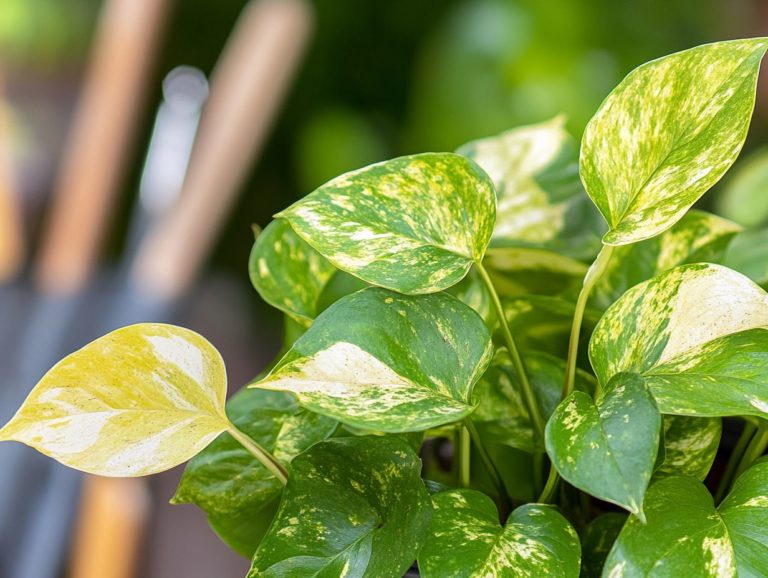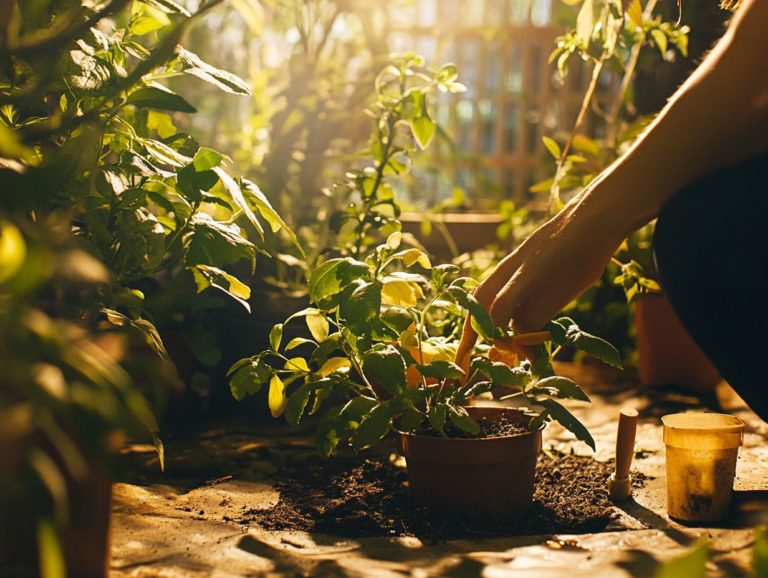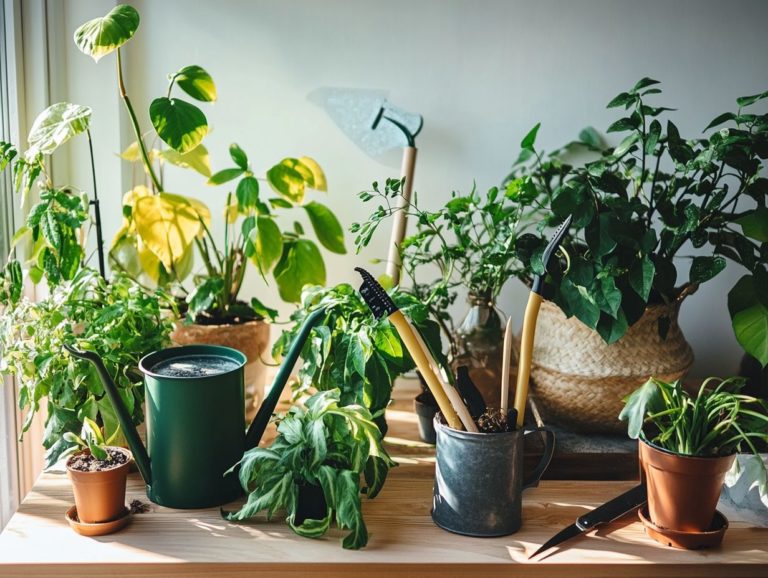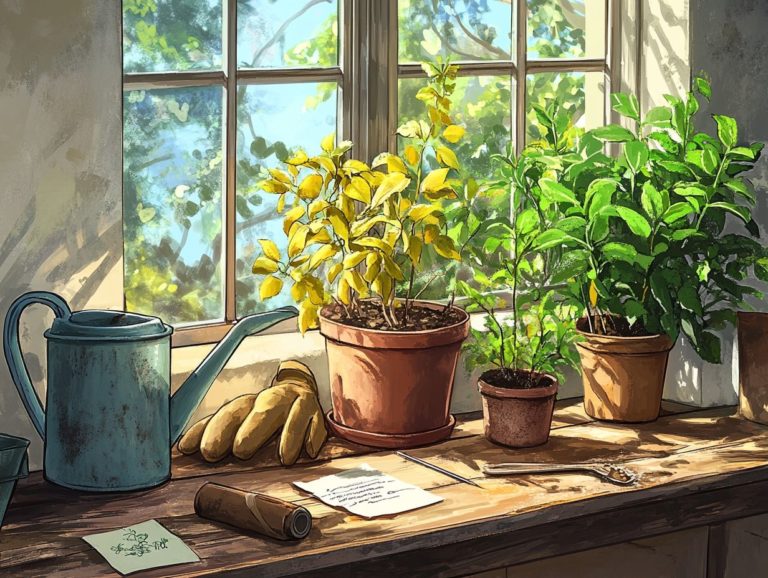How to Treat Fungal Infections in Indoor Plants
Indoor plants effortlessly infuse your home with nature s beauty, yet they can easily succumb to fungal infections that jeopardize their vitality and allure. Grasping the various types of fungal infections, identifying the symptoms, and understanding how to treat them is crucial for every dedicated plant caregiver.
This guide will help you keep your indoor garden thriving by exploring an array of treatments both natural and chemical as well as preventative measures to ensure your plants flourish. You ll also discover how to accurately identify and manage infected plants, keeping your indoor garden vibrant and healthy.
Delve into this knowledge to provide your plants with the exceptional care they truly deserve!
Contents
- Key Takeaways:
- Understanding Fungal Infections in Indoor Plants
- Treating Fungal Infections
- Preventing Fungal Infections
- Identifying and Removing Infected Plants
- Frequently Asked Questions
- Can I treat fungal infections in indoor plants with household remedies?
- What are some common signs of fungal infection in indoor plants?
- How can I prevent fungal infections in my indoor plants?
- Can I use natural fungicides to treat fungal infections in indoor plants?
- What should I do if my entire indoor plant is infected with fungus?
- Is it safe to use chemical fungicides on indoor plants?
Key Takeaways:
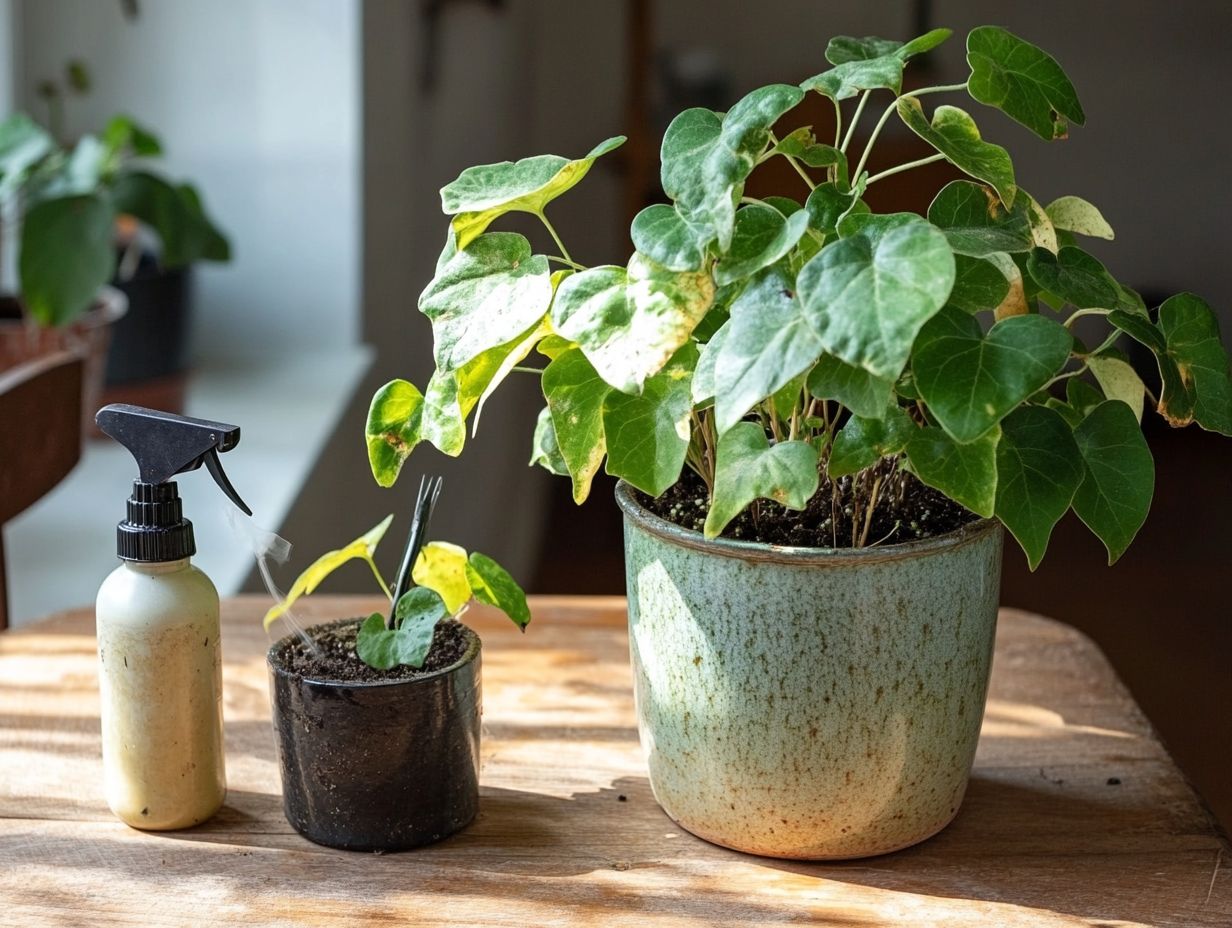
- Be aware of the different types of fungal infections in indoor plants and their common symptoms to effectively treat and prevent them.
- Consider using natural remedies or chemical treatments to treat fungal infections, but always follow proper safety precautions.
- Practice proper plant care and consider environmental factors to prevent fungal infections, and dispose of infected plants safely to avoid spreading the infection.
Understanding Fungal Infections in Indoor Plants
Understanding fungal infections in your indoor plants is essential for nurturing their health and promoting robust growth. These fungal issues can stem from various environmental factors, such as overly moist soil, poor air circulation, and insufficient disease resistance.
Indoor plants are especially vulnerable to a variety of fungal pathogens, resulting in ailments like powdery mildew, root rot, and sooty mold, all of which can significantly impact their vitality and visual charm.
By caring for your plants diligently, you can effectively prevent these fungal invasions and cultivate a thriving indoor plant ecosystem, enhancing plant growth.
Types of Fungal Infections
Several types of fungal infections can adversely affect your indoor plants, each presenting its own unique challenges and symptoms. Among these, powdery mildew reveals itself as a white, talcum-like coating that thrives in humid conditions and poor air circulation. It quietly weakens your plant as it takes away important nutrients.
Then there’s root rot, which is particularly insidious. It begins beneath the soil, creating a soggy environment that leads to mushy roots and, ultimately, the untimely demise of your plant if not addressed promptly.
Another common foe is Botrytis, notorious for the gray mold it produces, typically forming in overly moist conditions, especially on lush foliage and flowers. This can result in wilting and decay.
Anthracnose will show dark spots on leaves and stems, stunting growth and posing significant threats to overall plant vigor. Lastly, sooty mold, easily recognized by its black, soot-like appearance, develops in the presence of honeydew produced by sap-sucking insects, inhibiting photosynthesis and compromising your plant s health.
Each of these infections not only diminishes visual appeal but can also severely hinder your plant s ability to thrive.
Common Symptoms
Common symptoms of fungal infections in indoor plants include noticeable changes in plant tissue, such as leaf spots, black spots, and leaf drop, all of which signal underlying fungal diseases.
Beyond these visible signs, you might also notice a white, powdery coating on leaves often a clear indication of powdery mildew. Affected plants may show signs of wilting or stunted growth, suggesting that fungi are interfering with nutrient uptake.
Spotting mold on the soil surface can indicate fungal activity below. It s essential for you to regularly inspect your plants for these symptoms, as early detection can significantly enhance treatment outcomes.
By staying vigilant, you can ensure that your indoor plants remain healthy and thriving, even in the face of potential fungal challenges.
Treating Fungal Infections
Effectively treating fungal infections in your plants demands a thorough approach that incorporates both natural remedies and chemical treatments, tailored to the severity of the outbreak.
Natural Remedies
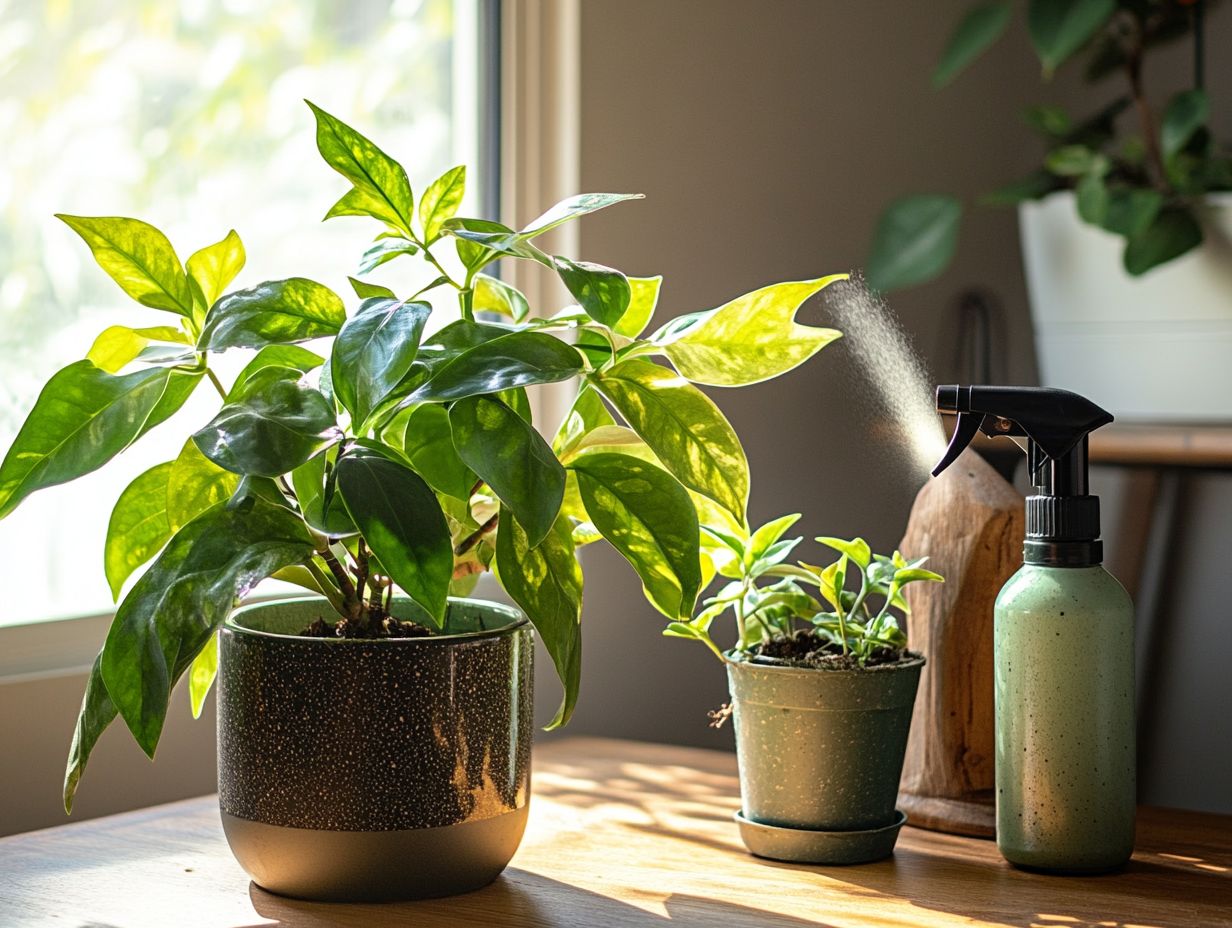
Natural remedies offer a gentle approach to treating fungal infections. Baking soda is one of the most esteemed organic solutions and acts as a key natural fungicide.
This versatile ingredient balances pH levels on your skin and creates an inhospitable environment for fungi. To use it, mix baking soda with water to form a paste and apply it directly to the affected area.
Other organic options like tea tree oil have natural antifungal properties. Remember to dilute it with a carrier oil before application. Coconut oil is also worth mentioning, as its medium-chain fatty acids disrupt fungal cell membranes.
Incorporating these remedies into your routine can lead to enhanced comfort and healing, while avoiding the harsh side effects of conventional treatments.
Chemical Treatments
For severe fungal infections threatening plant health, chemical treatments like fungicides such as Daconil and copper sulfate become essential. These substances target fungi and stop their growth, reducing the risk of damage to your plants.
Always follow the manufacturer’s instructions. For example, when using Daconil, mix it with water at the specified ratio and apply it during cooler parts of the day to lessen stress on your plants. With copper sulfate, moderation is crucial to avoid toxicity to beneficial microorganisms in the soil. If you encounter pests like thrips, check out this guide on how to treat thrips in houseplants. Always wear protective gear during application to ensure safety and treatment effectiveness.
Regularly monitor your treated plants to evaluate the treatment’s efficacy and make any necessary adjustments.
Preventing Fungal Infections
Act now to protect your plants from fungal outbreaks! Preventing fungal infections demands meticulous plant care. This includes adopting mindful watering habits, maintaining optimal humidity levels, ensuring proper soil drainage, and enhancing air circulation.
By taking these steps, you create an environment where your plants can thrive, free from the risks of fungal outbreaks.
Proper Plant Care and Maintenance
Effective plant care and maintenance are crucial for preventing fungal infections. Manage your watering habits and air circulation effectively.
A deep understanding of these factors significantly enhances your plants’ health and longevity. Striking the right balance between sufficient hydration and avoiding over-saturation is vital to prevent root rot. Regularly check soil moisture levels with a moisture meter or by feeling the top inch of the soil to establish a suitable watering schedule.
Promoting air circulation around your plants by spacing them appropriately can reduce humidity build-up, a prime breeding ground for fungus.
By adopting these best practices, you can create a healthier environment for your plants, leading to vibrant growth and impressive resilience.
Environmental Factors to Consider
Understanding environmental factors that contribute to fungal infections is crucial for maintaining a vibrant plant ecosystem. Pay attention to humidity levels, soil drainage, and air circulation.
These elements play a vital role in creating an ideal environment for your indoor plants. Excessive humidity breeds pathogens, while inadequate air circulation leaves plants susceptible to spore buildup. Poor soil drainage leads to root rot and invites common indoor plant fungi that thrive in damp conditions. Ensure your plants are positioned in areas with good airflow and monitor humidity levels closely to diminish infection risks.
By staying proactive about these conditions, you can cultivate a flourishing indoor garden and effectively fend off potential fungal outbreaks. Additionally, consider preventing pest infestations in indoor plants to ensure your plants remain healthy.
Identifying and Removing Infected Plants

Identifying and removing infected plants is an essential step in disease prevention. Signs of irreversible damage can easily spread fungal infections to healthy plants, disrupting the harmony of your entire garden.
Taking proactive measures ensures a flourishing and vibrant garden environment.
Signs of Irreversible Damage
Keep an eye out for serious signs of damage. They can signal dangerous fungal infections. Signs of irreversible damage from fungal infections include severe leaf drop, black spots on plant tissue, and an overall decline in plant vitality.
These symptoms often serve as critical indicators that your plant is facing more than just a minor problem. Wilting or stunted growth indicates underlying issues. Compromised root systems may struggle to absorb nutrients effectively.
The appearance of white mold or fuzzy growth on stems is a clear warning sign, indicating a threatening presence that demands immediate attention. Act quickly on these issues. Ignoring them may cause you to lose the plant completely.
This underscores the importance of vigilant monitoring and proactive measures to safeguard your plant’s health.
Disposing of Infected Plants Safely
Safely disposing of infected plants is vital! It prevents fungal infections from spreading and ensures effective disease management in your garden. This proactive approach not only protects your own plants but also shields neighboring gardens from potential outbreaks. To minimize risks, consider these strategies:
- Remove any infected foliage or plant material and place it in a sealed plastic bag to contain any spores. Avoid composting these materials, as the heat generated in typical compost bins may not eliminate all pathogens.
- Instead, look into municipal green waste programs, which can provide a safer disposal option.
- Remember to disinfect your gardening tools after handling compromised plants to prevent any cross-contamination.
By taking these precautions, you can cultivate a healthier gardening environment while significantly reducing the risk of fungal infections spreading. Additionally, consider learning how to use neem oil for indoor plants for effective pest management.
Frequently Asked Questions
Here are some common questions many plant owners have:
Can I treat fungal infections in indoor plants with household remedies?
Household remedies like vinegar and baking soda may provide temporary relief, but they are not effective in fully treating fungal infections in indoor plants. It is best to use specific fungicides designed for plants.
What are some common signs of fungal infection in indoor plants?

Some common signs include wilting, yellowing or browning of leaves, unusual growths or spots on leaves, and stunted growth. If you notice any of these signs, take action now!
How can I prevent fungal infections in my indoor plants?
The best way to prevent fungal infections is to maintain proper care for your plants, including proper watering, adequate sunlight, and regular cleaning of leaves. Avoid overcrowding plants and ensure they have good air circulation.
Can I use natural fungicides to treat fungal infections in indoor plants?
Yes, there are many natural fungicides available that are safe for indoor plants, such as neem oil, cinnamon, and hydrogen peroxide. These can be effective in treating fungal infections and also have less harmful side effects compared to chemical fungicides.
What should I do if my entire indoor plant is infected with fungus?
If the fungal infection has spread to the entire plant, it may be best to dispose of the plant to prevent the spread of the infection to other plants. Make sure to disinfect any tools or containers used with the infected plant to prevent further contamination.
Is it safe to use chemical fungicides on indoor plants?
Yes, it is safe to use chemical fungicides on indoor plants, as long as they are labeled for use on plants and are used according to the instructions. Be sure to wear protective gear and keep the plants away from children and pets when using chemical fungicides.

